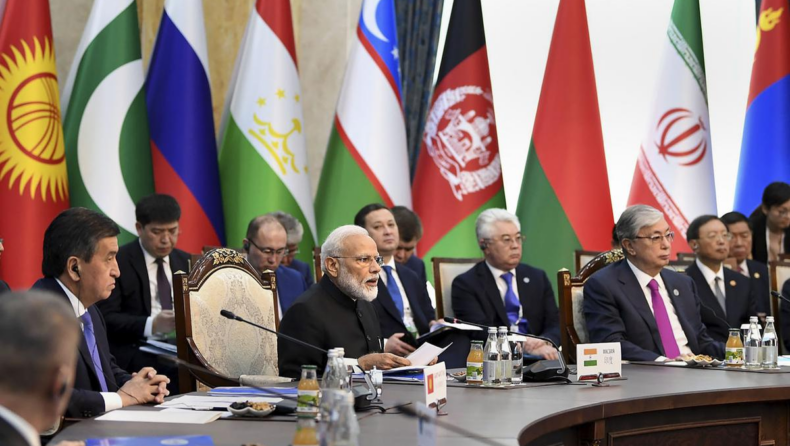India balancing all multilateral commitments of QUAD, SCO, and G-20 scheduled successively
The year-end of 2022 is an epochal challenge in India’s foreign diplomacy, with all major syndicates having their confronted gathering after a short gap due to the pandemic. These meetings are very arduous as they involve parties having a face-off.
- From September 5 – 6 an “Official meeting” of QUAD members was held in New Delhi.
- Followed by the 2+2 meeting between India & Japan on 8th September in Tokyo.
- And the meeting of the Council of Heads of State of the Shanghai Co-operation Organization (SCO) in Samarkand in Uzbekistan on September 15 – 16.
- Culminating, at last, is the G-20 Heads of State and Government Summit in November, presided by Indonesia (later by India on 1/Dec/2022 – 30/Nov/2023).
The evolution: “Non-alignment (NAM)” to “All-alignment foreign policy”

Global politics shifting from Non-alignment to All-alignment.
The NAM originated on 1961, formulated by the 5 leaders:
– Josip Broz Tito ———of—–> Yugoslavia.
– Gamal Abdel Nasser —of—-> Egypt.
– Jawaharlal Nehru ——of—–> India.
– Kwame Nkurmah ——of—–> Ghana.
-Sukarno —————-of——> Indonesia.
Their main agenda was to unfollow the ideologies of the two main power blocs the U.S. and the USSR (which arose post World War II) which needed the prorogation of other developing nations.
The proto-version of “NAM” began at the Vienna Congress meet of 1814 – 1815 after the death of French Emperor Napoleon Bonaparte with and subsequently the recent one was formulated post World War – II (1961).
With the the Hague convention – 1907, several other nations like Switzerland, Austria, Finland, Costa Rica, Sweden, Malta, Ireland, Liechtenstein, Turkmenistan and Vatican City have completely abided binding neutrality renouncing any form of armed conflict (even today).
However, several nations like Japan, India, Iran and Turkey have evolved into selective alignment/need-based defence strategies. Whereby these nations are having common grounds like a common threat (China – for Japan and India), a common ally (U.S. – for India and Japan), or a common sanction imposed (U.S. imposed CAASTA on Turkey and JCPOA on Iran).
The challenges to Indian foreign policy in the balancing act
India evolved the strategic alignment purely instigated by the contingencies faced during Indo-Pak / Indo-China wars,
in the most needed times of Indo-Pak wars, the U.S. refused to share its GPS satellites with India and instead bolstered Pakistan, and U.S.S.R rushed to rescue India, similarly, Russia (U.S.S.R) stood neutral in any conflict between India and China (due to its dual priorities).
India evolving equipoised foreign policy
India is on a zig-zag walk on a barbed track, trying to moderate between its allies in an amiable manner depending on its national interest, and India has been evolving its foreign diplomacy since the Nehruvian era to date.
From being conservative and a closed economy, India has gradually progressed after independence and drastically after the LPG reforms of 1991, allowing FDIs and taking part in international affairs, as documented below:-
- India took a neutral stand on the U.S.S.R. invasion of Hungary in 1956.
- India established diplomatic relations with all the erstwhile U.S.S.R. States post collapse of the regime in 1990.
- India-U.S. signed the “Joint Comprehensive Agreement” in 1992, which evolved into a “Nuclear Deal”.
- India-China held its first border negotiations in 1993.
Even in recent, India has remained neutral following the principle of “non-intervention” over the foreign nation’s sovereignty, which can be seen as:-
- India stood neutral over the “Black lives protest” incident in the U.S. in May/2020.
- India respected the sovereignty of its neighbors and un-interfered regardless of their eco-political crisis (Eg:- Pakistan, Afghanistan, Sri Lanka, Myanmar, Nepal). Rather, it extended possible assistance in form of logistics and credit regardless of acrimony in certain cases.
- India stood neutral on the recent Russia-Ukraine conflict.
- India selectively parted the Russian military exercise (at Vostok) and averted the maritime exercise (nearby Kuril Islands), as Japan has a dispute.
A stable foreign policy in the disarray

India always prioritized its sober agendas in any grouping with its ‘panchasheel principles’ and restricting militarization has been both pleasure and pain at times,
- India despite being a member of SAARC stays passive to avoid confronting Pakistan.
- BIMSTEC lacks regional cooperation with no effective progress like western cliques of NATO, AUKUS, G-7 etc., worsened with turmoil in Myanmar.
- India had to face stifling situations to bargain the S-400 deal against the CAASTA sanctions, yet was unable to develop the Chabahar-port of Iran (leveraging China to fill the vacuum).
- India is aiming to build the INSTC corridor in Central-Aisa but is precarious about unrest caused due to Taliban, Pakistan, and Hezbollah (in Iran & Saudi Arabia).
- Russia & U.S. prevaricates based on their priorities.
Eg:- Russia – China trade is 10 times that of India – Russia.
U.S. unsupported India regarding patent waiver on WTO.
- The “Atmanirbhar” policy of India might not favour FTAs needed to bolster diplomacy.
Areas to focus
- India must exit various futile organizations that encumber the progress like IBSA, IORA, APEC etc.
- India must declare a strong agenda in regional groupings of BRICS, SAARC and BIMSTEC, and attract cooperation from ASEAN.
- Self-reliance in selective sectors like defence, intelligence and human resources serves better.
- India must invest in utilizing international laws because Indian diplomats are poorly equipped to cite them to defend national priorities, which is an underfunded sector.
Read More – G20: India’s Test And Challenges – Asiana Times













